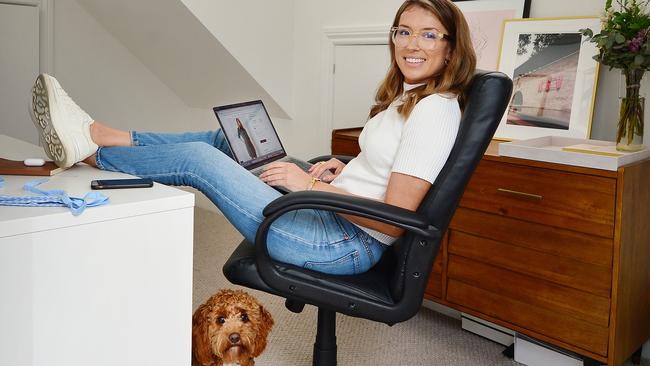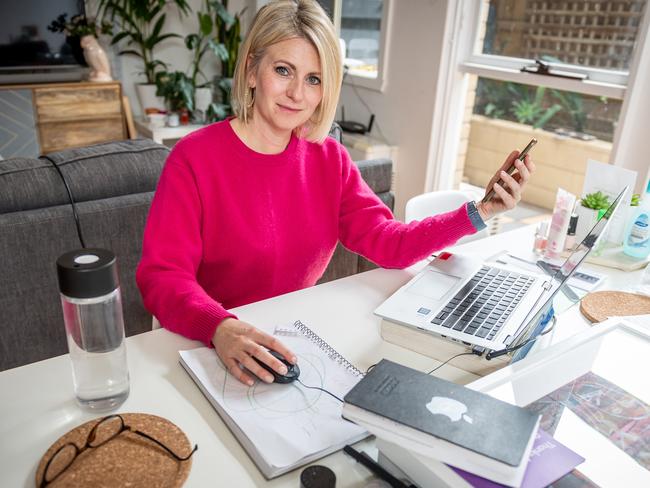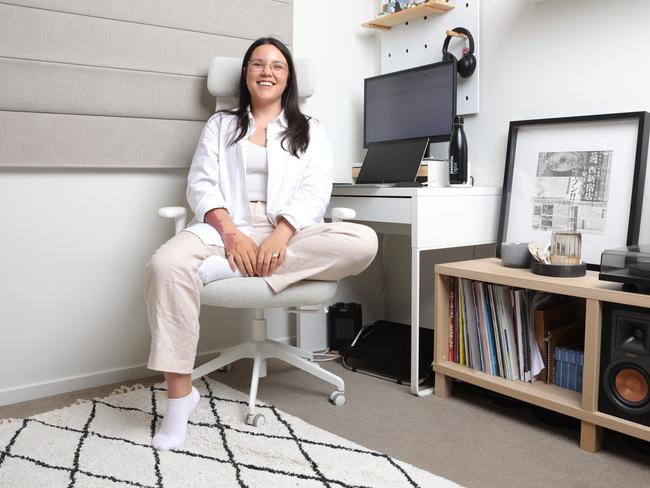Future Victoria: Hybrid WFH and office model here to stay, and our homes will be super hi-tech
Victoria’s industry leaders say the future of work will make “our office wherever we are at the time”. For many of us, that will be in our hi-tech homes.

News
Don't miss out on the headlines from News. Followed categories will be added to My News.
What does the future of work look like? We asked experts to tell us how they believed we’d be working in 2030, and one thing was certain: A lot of us would be working from home, quite a lot of the time, with visits to the office for meetings, collaboration and socialisation. It’s likely some of us will work for overseas companies, from our homes in Victoria. One expert also said “the four-day work week beckons”.
Victorian Chamber chief executive Paul Guerra
Life in 2030 will be a true intersection of human engagement and technology. The internet will provide unparalleled speeds and accessibility wherever you are and we will have new, as yet unheard of, platforms to enable us to connect. And as this develops so too will our workplaces. We will take the gains of being able to work anywhere but most of us will still crave in-person connections. We will also move to outcome based roles with the flexibility of engaging both virtually and in person. The office will still feature but will evolve to a space which enables great collaboration. Our office will also be wherever we are at the time. A truly global workforce will enable us all to have a truly global role if we want it. It will be bold and exciting, and personal connection will remain at the core of the way we work.

Delos Delta managing director Brook Dixon
Within the decade, working from home will become more prevalent. For more people, and more industries, all enabled by more technology. New digital devices, faster internet connectivity, innovative computer programs, and augmented/virtual reality will continue to drive the WFH trend.
Ultimately, this trend should result in more choice and opportunity for employees. The choice to work from home, the office, a co-working space, local park, cafe or library. And the opportunity to engage in a global employment market without moving homes. Indeed, in the next decade, as a society we may well decide that the productivity of digital technology and WFH is best invested in working less. The four-day work week beckons.
University of Sydney Business School (Institute of Transport and Logistic Studies) Professor Matthew Beck
We will likely see the adoption of what is occurring now, where working from home will continue to some extent; those who can spend roughly 20-40 per cent of their time working from home, the rest the office. The office has a blend of positive and negative attributes, much like working from home, so the hybrid approach will be the dominant structure. As more jobs become tech-enabled we can expect to see more workers adopting some WFH into their work mix (even for site-based workers like tradespeople, the ability to complete much of their paperwork from home has been a positive). The flexibility this affords workers to both better complete work by being able to schedule it around their life activities in a more seamless fashion, creates less disruption to that work and also happier more productive employees.

Chapel Street Precinct Association general manager Chrissie Maus
Nothing has changed more dramatically in the past 18-months than the way we work. I never thought that I would see my kitchen table set up as a permanent home digital broadcast studio and yet I have no doubt it will become a permanent fixture next to my Weetbix bowl.
No longer do we need to sit at our company office desks from 9-5. I usually work now from home at least one or two days a week, by 2030, I would suggest I would only be going in for meetings or socialising.
The focus will be on what’s delivered, not how many hours you’re slaving away. In 2030, when teams do get together, it will have more of a social focus and be over a drink or meal. Blue sky ahead for our local businesses.
As we continue to navigate the pandemic, supporting local businesses and local shopping altruism can be the elixir that energises not only our local economy but also ourselves.
Leading child psychologist Michael Carr-Gregg
Rituals and traditions will be vital for families in the next decade. So schedule time to ensure that family time happens through family movies, pizza or games night. It will still be vital to make meal time sacred family time when you sit down together for dinner and take turns sharing the day’s events. Lastly, ensure that you take time for yourself. Diet, exercise and sleep are the building blocks of wellbeing for everyone. Taking time for yourself has to be a priority. It’s something you should do no matter how tired you are. Drag yourself out the door to your fitness class, afterwards you will be in better humour and happy that you did something for yourself. Have your one favourite show a week and protect that time. After you tuck the kids in bed, make that bowl of popcorn and sit down and watch your weekly drama.
Homes of the future
The homes of Victorian families will have more technology than ever in the coming decade revolutionising the way we live.
Brook Dixon, managing director of Delos Delta, who specialise in smart city expertise, said homes in the next decade needed to promote sustainability and feature a suite of other technological advancements.
“Smart water meters will give us real time visibility of water consumption and the ability to minimise our bills and make sure that we’re using water in an efficient way,” Mr Dixon said.
“For internet, we also need fibre going to the house and then you’ll have the ability to include more technology in the house.”
Mr Dixon said there would also be a “greater uptake” of electric vehicles.
“Most new homes and existing homes will start to have EV charging stations.
“For example you might have an EV charging station in a set of flats and apartment buildings and having it connected to the internet allows people to understand when it’s free and what time it’s used.”

Mr Dixon said other additions to homes in the next decade included solar panels and environmental condition sensors.
“Big buildings are already doing this, they have a granularity of temperature sensors right across the building to understand the thermal conditions of the building to optimise airconditioning and air circulation.”
He said there will be more people working from home by 2030.
“I expect to see homes become a bit of a hybrid between where you work and where you live. There will be a greater introduction of office space and work-based technology into the home which might include multiple screens and video conferencing equipment.”
Mr Dixon said governments and major sectors all had roles to play in building smarter homes and cities.
“Governments need to ensure its planning and policy settings promote the production of smart houses and for homeowners to take advantage of technology when it can save us money and help us reduce greenhouse gas emissions.”
Swinburne University lecturer in Architectural Engineering and founder of Curvecrete Daniel Prohasky said he would challenge smart homes being ‘smart’ when they are full of sensors and technology.
“A smarter home could include a green facade, one that is absorbing Co2 emissions and one that’s a positive influence on itself,” Mr Prohasky said.
“At Curvecrete we create beautiful curved architecture, which is lower carbon and could last about 300 years … adding that green element and understanding how the home is integrated with its ecosystem is important.”
Recycled water will also be an option for smart homes and new estates through the use of purple pipes, which will be more cost-effective for homeowners.

Local parklands, fountains and sporting grounds across Victoria will also benefit from the pipes.
Easy Living Home Automation director Scott Andrew, who specialises in smart home automation, said Victorians were already making the most of using new technologies in their homes.
Some of the technology Mr Andrew is installing in homes includes security, entertainment and lighting automation.
“Homeowners are getting lighting, TVs and security cameras automated in their homes,” Mr Andrew said.
“People with disabilities that have lost the use of their hands are engaging more with voice control technologies and this gives them a better quality of life.”




